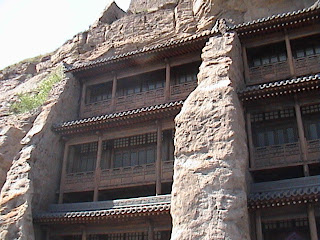2006
Seated statue of the 13.7 m high Sakyamuni
The Yungang Grottoes are ancient Chinese Buddhist temple grottoes, cut
from rocks, and is one of the three most famous ancient Buddhist sculptural
sites of China; the others being Longmen (Luoyang) and Mogao (Dunhuang).
Entrance to the Grottoes
Datong is about 6 hours' train ride from Beijing; one can take a night train from Beijing to Datong reaching it the following morning. Take a bus at
Datong Railway Station, get off at Xin Kai Li and transfer to another bus
to Yungang Caves. Better still, if you have four people in your group, just hire a taxi to Yungang Grottoes from Datong. It may work out to be much cheaper and more convenient, saving you time and stress. After you are done with Yungang Grottoes, then just hop onto the night train for Beijing.
Caves in Yungang
There are 45 main caves, 252 shrines and over 51,000 figures in this grottoes; the Caves are divided
into eastern, western, and middle parts, where pagodas dominate the
east, with small and mid-sized niches in the west, and Buddha statues in the middle.
Here are more pictures of Yungang Grottoes for you to drool over ... The pictures speak for themselves.
Pagoda-shaped pillar in the center of the cave.
Delicately carved Buddha statues of various postures can be seen.
Is it worth going to Yungang Grottoes? Well, if you think that queing up for minutes, and sometimes hours, just to have a quick glance at the Mona Lisa in the Louvre is an "art" thing, then the following picture should make you pack your bags and head to Yungang ... this mysterious smile was



















No comments:
Post a Comment